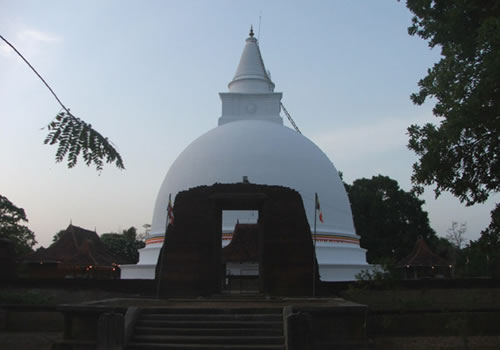Cultural
- Ancient City of Polonnaruwa (1982)

Polonnaruwa was the second capital of Sri Lanka after the destruction of Anuradhapura in 993. It comprises, besides the Brahmanic monuments built by the Cholas, the monumental ruins of the fabulous garden-city created by Parakramabahu I in the 12th century.
- Ancient City of Sigiriya (1982)

The ruins of the capital built by the parricidal King Kassapa I (477–95) lie on the steep slopes and at the summit of a granite peak standing some 370 m high (the 'Lion's Rock', which dominates the jungle from all sides). A series of galleries and staircases emerging from the mouth of a gigantic lion constructed of bricks and plaster provide access to the site.
- Golden Temple of Dambulla (1991)

A sacred pilgrimage site for 22 centuries, this cave monastery, with its five sanctuaries, is the largest, best-preserved cave-temple complex in Sri Lanka. The Buddhist mural paintings (covering an area of 2,100 m2 ) are of particular importance, as are the 157 statues.

Founded in the 16th century by the Portuguese, Galle reached the height of its development in the 18th century, before the arrival of the British. It is the best example of a fortified city built by Europeans in South and South-East Asia, showing the interaction between European architectural styles and South Asian traditions.
- Sacred City of Anuradhapura (1982)
This sacred city was established around a cutting from the 'tree of enlightenment', the Buddha's fig tree, brought there in the 3rd century B.C. by Sanghamitta, the founder of an order of Buddhist nuns. Anuradhapura, a Ceylonese political and religious capital that flourished for 1,300 years, was abandoned after an invasion in 993. Hidden away in dense jungle for many years, the splendid site, with its palaces, monasteries and monuments, is now accessible once again
- Sacred City of Kandy (1988)

This sacred Buddhist site, popularly known as the city of Senkadagalapura, was the last capital of the Sinhala kings whose patronage enabled the Dinahala culture to flourish for more than 2,500 years until the occupation of Sri Lanka by the British in 1815. It is also the site of the Temple of the Tooth Relic (the sacred tooth of the Buddha), which is a famous pilgrimage site.
Natural
Sri Lanka's highlands are situated in the south-central part of the island. The property comprises the Peak Wilderness Protected Area, the Horton Plains National Park and the Knuckles Conservation Forest. These montane forests, where the land rises to 2,500 metres above sea-level, are home to an extraordinary range of flora and fauna, including several endangered species such as the western-purple-faced langur, the Horton Plains slender loris and the Sri Lankan leopard. The region is considered a super biodiversity hotspot.
- Sinharaja Forest Reserve (1988)

Located in south-west Sri Lanka, Sinharaja is the country's last viable area of primary tropical rainforest. More than 60% of the trees are endemic and many of them are considered rare. There is much endemic wildlife, especially birds, but the reserve is also home to over 50% of Sri Lanka's endemic species of mammals and butterflies, as well as many kinds of insects, reptiles and rare amphibians.
Properties submitted on the Tentative List (2)

Seruwila Mangala Raja Maha Vihara is an ancient temple which is among the sixteen holiest Buddhist shrines [Solomathana] in Sri Lanka.
It is reachable both from road and sea. Sea route begins at Trincomalee to Muttur on boat and another 16 km by roads. Land route is via Kantalai, to Allai which is approximately 45 km through dense forest.
List of Monuments in the complex:
- Stupa - Origin 2nd Century B.C. - restored in 1920's.
- Restored Northern entrance - This building has evidence of molded bricks, balustrades, guard stones and moonstones. In addition there is ruined ceremonial gateway with carved stone door frame.
- Western entrance - Evidences of preliminary stages of stone works in moldings showing exemplary stone jointing methods.
- Southern entrance - Balustrades with elephant motifs, guard stones and stone door frame etc.
- Eastern entrance
- Image house building at the Stupa terrace
- Sculptured stone lotus
- Bo tree shrine [Bodhighara]
- Ancient pond
- Remains of ancient Chapter House
- Remains of monasteries
- Remains of a building on stone pillars
- Natural stone platform and caves with primitive paintings

Coordinates:
1. Seruwila - N8 22 14 E81 19 12
2. Trincomalee - N8 35 32 E81 11 47
I. Koddiyar bay - N8 29 59 E81 14 51
II. Koneshwaram - N8 34 56 E81 14 43
III. Kompanachchi - N8 10 E81 13
3. Somawathie - N8 7 39 E81 11 49
4. Polonnaruwa
Ι. Dalada Maligawa - N7 56 52 E81 00 04
ΙΙ. Dimbulagala - N7 52 2 E81 07 02
ΙΙΙ. Pulligoda -
5. Mahiyangana - N7 19 15 E80 59 28
6. Teldeniya -
7. Kundasale - N7 16 48 E80 41 26
8. Katugastota - N7 18 58 E80 37 16
9. Kandy
Ι. Dalada Maligawa - N7 17 37 E80 38 29
ΙΙ. Gangaramaya - N7 17 45 E80 38 59
ΙΙΙ. Asgiriya - N7 17 58 E80 38 07
ΙV. Natha Devale - N7 17 37 E80 29 59
10. Gampola
I. Town - N7 09 50 E80 34 13
II. Gadaladeniya - N7 15 26 E80 33 21
III. Ambekke - N7 13 04 E80 34 03
IV. Lankatilaka - N7 14 02 E80 33 54
V. Kehelgamuwa - N6 54 00 E80 29 57
11. Sri Pada - N6 48 33 E80 29 59
Regards,
Isurudewa

No comments:
Post a Comment